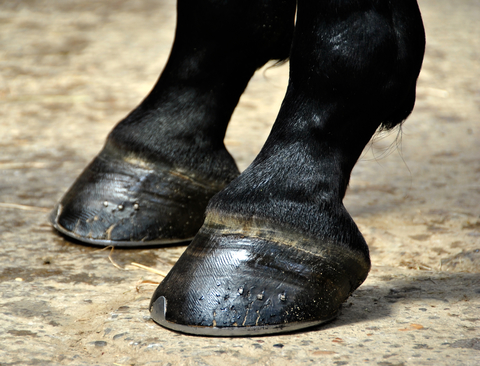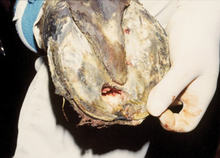Quick facts
Establish a good working relationship with your farrier and veterinarian to ensure your horse stays healthy and sound. Many foot problems can occur in horses. To reduce hoof problems:
- Schedule regular trimming or shoeing.
- Maintain good hoof balance.
- Provide appropriate shoeing for different weather and footing conditions.
- Provide appropriate treatment when disease occurs.
- Maintain proper horse nutrition.
How often should you trim or shoe your horse’s hooves?
Summer
Trim or shoe hooves at least every 6 to 8 weeks in the summer. Show horses may need more frequent trimming.
Winter
Because the horse’s hooves grow slower in the winter, you should trim or shoe hooves every 6 to 12 weeks. This time interval may be different between horses based on their hoof growth.
Learn how to care for horse hooves in the winter.
Keeping the hooves balanced
Horses with balance hooves move better and have less stress and strain on bones, tendons and ligaments. The ideal foot has:
- A straight hoof-pastern angle.
- A straight line from the pastern down through the front of the hoof wall.
- This correctly lines up the bones between the pastern and coffin bone.
- Easy break over.
- The toe is not too long and is squared, rounded or rolled.
- This allows easier movement with each step.
- Too much break over can result in health problems.
- Adequate heel support.
- The shoe extends back to the end of the hoof wall and supports the back of the entire leg.
- The back edge of the shoe is under a line drawn down the center of the cannon bone.
- Medial-lateral balance.
- The foot lands evenly from side to side as the horse walks.
Selecting a farrier
Routine hoof care is essential to your horse’s health. Regular trimming and, in some cases, shoeing can help keep your horse sound and performing. Having a farrier that works well with your horse and is willing to meet their individual needs is important.
Often, the best way to find a farrier is by word of mouth. Your veterinarian, industry professionals and other horse owners are good resources.
The Minnesota Horseman’s Directory lists local farriers.
Education
Farriers enter their profession through formal education, apprenticeship or a combination of the two. A farrier should be knowledgeable about their field. Anyone can trim and shoe horses in the U.S. because no license or certificate is required.
A farrier should be well-versed in horse anatomy, physiology and biomechanics. They should also be able to read a radiograph of the foot.
Many good farriers continue their education through reading or attending clinics, seminars and conferences. Ask the farrier if they belong to any organizations such as the Minnesota Farriers Association.
Experience
Ask the farrier about their previous experience trimming and shoeing horses.
- How long have they been practicing?
- How often do they practice?
- Do they have any areas of specialization?
- Some farriers specialize in a certain breed or riding discipline.
Make sure the farrier’s experience meets your horse’s needs.
Horsemanship
Watch how the farrier interacts with horses.
- Do they spend time watching how the horses move and land on their feet?
- Do they work quietly and calmly around horses?
- Do the horses behave and work well with the farrier?
These interactions affect the farrier’s work quality but also the safety of all involved.
Attitude
Make sure the farrier
- Enjoys their work.
- Doesn’t rush.
- Pays attention to detail.
- Cares about the horse and owner’s welfare.
- Is on time and reliable with appointments.
- Calls when running late.
- Is willing to work with a veterinarian if needed.
Communication
- Choose someone who is easy to communicate and get along with. This should include conversations about the horses' needs and the owner’s goals and budget.
- Your farrier should be willing to discuss and explain the trimming or shoeing process.
- Make sure they’re easy to reach during an emergency situation.
- Farriers and horse owners should work together cooperatively and share mutual respect.
Cost
Cost will vary by region and the horse's needs. Ask other horse owners in your area or discipline what they are paying for similar services.
Never choose a farrier based on cost alone. The important issue is not the cost, but the quality of service.
A more experienced farrier can be expected to charge more than someone new to the profession.
Once you find a farrier that works for you and your horse, here are some tips to keep a good working relationship with them.
Scheduling
Maintain a routine trim schedule even during the winter. Horses usually need a trim every 6 to 8 weeks.
Workspace
Have a flat, clean and well-lit area for your farrier to work in. This will provide a safe area and help your farrier complete quality work. A rubber mat can add traction and comfort for both the horse and your farrier.
Horse behavior
- Make sure your horse stands nice, is clean and well behaved.
- Tie your horse and practice picking up their feet.
- You should pick out each hoof daily.
- Never tolerate kicking, biting, leaning or pulling the leg away.
Horsemanship
Learn how to properly handle and discipline your horse. Ask for help from an experienced or professional horseman if needed.
Be prepared
Have your horse caught, brushed and ready for the farrier. This is especially important if multiple horses are scheduled to be trimmed or shod.
Payment
- Make sure you understand your farrier's fee structure.
- Make your payments promptly.
- Schedule and cancel appointments in advance.
Common hoof problems
Nutrition can help some hoof problems
- Feed good quality hay.
- Correctly supplement vitamins and trace minerals.
- Provide constant access to fresh, clean water.
- Correct poor nutrition can lead to gradually improved hoof health.
- Cooperate with veterinarians and horse nutritionists to set up a good nutrition plan.
Research shows poor quality hooves can benefit from commercially available hoof care products that contain:
- Biotin (20 milligrams per day)
- Iodine (1 milligram per day)
- Methionine (2500 milligrams per day)
- Zinc (175 to 250 milligrams per day)
- Long toes and collapsed heels strain flexor tendons and the navicular bone.
- Short toes and long heels cause trauma to the coffin bone and joint.
- Imbalanced hooves cause stress on supporting ligaments and joints.
Causes
- Dry weather, or frequent changes from wet to dry.
- Drawn-out trimming intervals and long toes.
- Poor hoof quality; some horses may be born with it.
Treatment tips
- Apply hoof moisturizers to the hoof wall and sole during:
- Dry weather.
- Periods of brittle or cracking hooves.
- Provide good nutrition and commercially available hoof supplements to improve hoof quality.
- Regularly trim your horse’s hooves.
Types of hoof cracks
- Horizontal cracks and blowouts occur following injury to the coronary band or blow to the hoof wall. This hoof problem generally doesn’t cause lameness.
- Grass cracks commonly occur in horses with long, unshod hooves. Trimming and shoeing can correct these cracks.
- Sand cracks result from injury to the coronary band or white line disease that breaks out at the coronary band. Sand cracks may result in lameness.
Treatments can include
- Determining the cause of the cracks and removing it.
- Floating the hoof wall (not letting it bear weight).
- Patching the crack.
It usually takes nine to 12 months for a horse’s hoof to grow out.
- Thrush is a foul-smelling black oozy liquid around the frog.
- Thrush occurs in wet, soiled conditions.
- Thrush invades the sensitive tissues of the hoof and causes lameness.
- You can treat by keeping your stalls or barn clean and dry.
A solar abscess is an infection in the sole of the hoof. Solar abscesses lead to sudden or severe lameness. Causes of solar abscess include trauma, bruising, or a foreign body.
Treatments include:
- Removing the foreign body (if possible).
- Soaking the hoof in warm water and Epsom salt.
- Keeping the hoof bandaged, clean, and dry.
A hot nail is a horseshoe nail within a sensitive area of the horse’s hoof. Hot nails will generally cause lameness.
Treatments include:
- Cleaning the nail hole with antiseptic, a wash that prevents germ growth.
- Packing the hole or bandaging the foot.
- Providing a Tetanus booster.
A street nail is any foreign object that enters the horse’s foot. Call your veterinarian immediately if your horse has a street nail. Treatment will depend on the location of the injury.
Laminitis, also called founder, is swelling of the sensitive laminae. The lamina is a connective tissue located inside the hoof. Swelling causes the coffin bone to rotate or sink downward within the hoof. There are several causes of laminitis.
Treatments include:
- Regular shoeing or trimming.
- Keeping short toes.
- Keeping frog and sole support.
Reviewed in 2024




